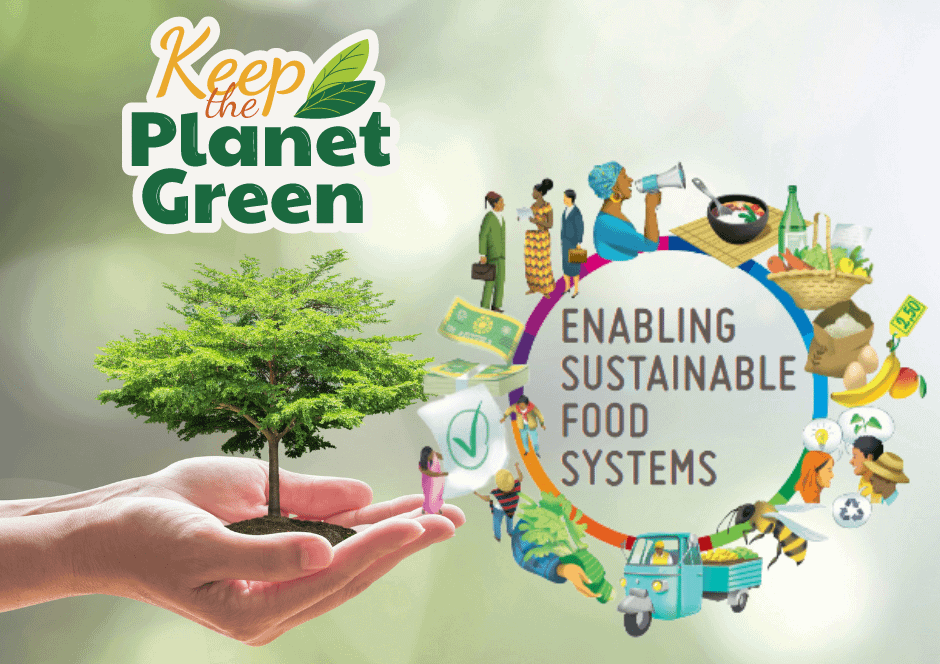Sustainable Food: Your Ultimate Guide to Eco Friendly Eating

What is sustainable Food?
Sustainable food is produced, processed, distributed, and consumed in ways that minimize negative environmental impact while promoting health, social equity, and economic viability. The main focus is practices that conserve natural resources, reduce carbon emissions, and encourage biodiversity.
The world is literally on red alert today due to climate change and environmental degradation. Therefore, there can hardly be a better time than today to start making sustainable food choices that may help improve your health and your deteriorating carbon footprint and help grow local economies.
Sustainable food includes eating locally sourced foods, beginning a home garden, and reducing waste. We consider these points here because adopting the most sustainable food practices is now increasingly simple and rewarding. Incorporating these habits into everyday life is a key part of Sustainable Living, which helps protect the environment and promotes a more balanced, eco friendly lifestyle.
Sustainable Food Practices
1. Drive for Local Food Consumption
One of the simplest ways to make greener food choices is by buying locally grown foods. Buying locally will support the local farmers, and buying locally is a great way to help build a more sustainable food system—not to mention that it’s better for the environment, better for the community, and better for your health. Here’s why:
These are markets which support the local economy; the money keeps circulating between various people who live in the community. Small-scale farmers continue operating, creating new jobs to support the local economy, ensuring that money stays within the local economy and doesn’t flow out to large corporations or distant suppliers.
Low Carbon Footprint: The prime benefits associated with sustainable foods are low emission that emanates from transportation. Most imports and non-local food have to cover thousand-mile distances before it is made available at your local grocery store. These long drives burn fossils that release toxic fumes into the atmosphere. Local eating reduces the amount of greenhouse gases involved in its shipment, thus keeping the atmosphere clean.
We harvest locally sourced produce at its peak for maximum nutrition and flavor.” It keeps food fresh and healthy; it does not have to spend days, or sometimes even weeks, in transportation procedures. It is good not only for your health but also for the environment.
Choosing locally produced foods, maximizing their health benefits, and supporting an environmentally conscious food system is key to sustainable eating.
2. Raise a garden in the backyard to have fresh produce and veggies.
One way to exercise food sustainability is through gardening and homegrown food. Furthermore, participating in this activity not only brings enjoyment but also guarantees a continuous supply of fresh, healthy food, reducing reliance on store-bought options. It is one absolutely great way to live an extra-sustainable life.
Site selection:
Choosing where to site your garden is the most critical feature for a productive abundant garden. Vegetables and herbs thrive in full sun, needing at least six hours of sunshine daily. You can grow a garden in pots, raised beds, or using vertical gardening techniques in any space, from yards to balconies.
What to grow:
Choose what thrives in your climate and in your soil. Basil, cilantro, and parsley—all are easy herbs to grow for the beginning gardener. The home-grown vegetables one can grow are tomatoes, lettuce, and peppers. If you love it, you will tend it, and if you tend it, you’ll eat from it.
Soil Preparation:
The soil is the foundation of any good garden. Enrich quality by mixing in organic compost or fertilizers. Composting foods at home adds a good deal of organic fertilizer to soil for higher nutrient value in soil, which proves good for viable food growth.
Garden care:
A garden, after its planting, calls for good care. Remember to water your plants regularly, especially during dry periods, and use organic pest control methods. Other sustainable gardening practices include companion planting, which means that one plant aids in the growth of another, and maintaining a healthy ecosystem without the use of chemicals.
Harvest time:
Eating the fruits and vegetables from weeks of caring for the plants. It feels great to grow your crops, knowing definitely that they are grown in a sustainable way, without the use of pesticides and any other inorganic chemicals. You also become less dependent on supermarket produce; hence, you’re more self-sufficient with your diet.
For example, home gardening is one of the best ways to put in place more sustainable food into one’s life and reduce dependence on the conventional food system.
3. Best Sustainable Food practice that helps reduce food waste at home.
Food waste is another important constituent of sustainable food choice. It is estimated that one-third of all food produced globally is lost or wasted. When this food, if wasted, decays in landfills, it contributes to greenhouse gases. Being just a little more mindful about the purchase, storage, and use of food goes a long way toward reduction of loss.
The other best way to reduce food waste is to meal plan. After meal planning, make a shopping list to avoid buying unnecessary food and save money.
One of the most important ways to prolong practical food life is knowing proper food storage. Many foods will stay fresh for much longer with special methods of storage. The greens will not wilt if stored in a breathable bag, and the bread or meat can be frozen for several weeks, or even months beyond what it otherwise would.
Creative Leftovers Leftovers are never boring; rather, you can always remake leftovers into new meals. The roasted vegetables from yesterday could be your soup today. That leftover cooked chicken could also have been turned into a succulent sandwich or salad. It is this kind of creativeness with leftovers that diminishes waste and simply adds variety to your meals.
Compost food scraps: Even the best-planned meals generate some type of food waste. Instead of sending this waste to the landfill, share your vegetable peels, coffee grounds, or eggshells through composting. Composting will transform those food scraps into nutrient-rich soil for use in your garden—just one more step toward a more sustainable food lifestyle.
Conclusion:
Sustainability means sustaining food, eating healthily, leaving a lesser footprint on Earth, and helping towards a better future. Adding more locally sourced foods to your diet, producing your food, reducing waste, and embracing a zero-waste lifestyle are vital steps to a more sustainable life. Integrating these practices into your routine contributes to sustainable living and helps preserve the planet for future generations.
